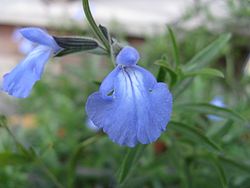Top Qs
Timeline
Chat
Perspective
Salvia azurea
Plant species in the family From Wikipedia, the free encyclopedia
Remove ads
Salvia azurea, the blue sage or azure sage, is a herbaceous perennial in the genus Salvia that is native to Central and Eastern North America.[3][4]
Remove ads
Description

Blue sage is a perennial plant with stems that reach 0.5 to 1.5 meters (1 ft 8 in to 4 ft 11 in) when fully grown. Plants may have one stem or several which grow from a thick caudex.[5] The leaves are connected to their stems by petioles to 0.4 inches (1.0 cm) long narrow, pointed, smooth-edged to serrated, furry to smooth. There are no basal leaves.[6]
The blue flowers (rarely white), nearly 1⁄4 to 1⁄2 inch (6.4 to 12.7 mm) long, appear summer to autumn near the ends of their branched or unbranched spikes; their calyxes are tubular or bell-shaped and furry. Two varieties are known, Salvia azurea var. azurea (azure sage) and Salvia azurea var. grandiflora (Pitcher sage).[3][4]
The stems of wild S. azurea tend to be long and unbranched, causing them to flop under the weight of their flowers.[7][8][9] When grown in cultivation, the stems of S. azurea are sometimes cut back early in the growing season to encourage branching and slow the vertical growth of the plant to prevent lodging.[7][8]
Remove ads
Taxonomy
Salvia azurea was scientifically described by Martin Vahl in 1804, but attributed its description to André Michaux. It is classified in the Salvia genus in the family Lamiaceae. According to Plants of the World Online and World Flora Online it has no valid varieties or subspecies.[2][10] However, World Plants lists Salvia azurea var. grandiflora as valid as does the Natural Resources Conservation Service database.[11][12]
Names
Salvia azurea is known by the common name blue sage.[5] It is additionally known as Pitcher sage,[5] azure blue sage,[12] and azure sage.[13] It is also sometimes known as prairie sage.[14]
Remove ads
Distribution and habitat
Summarize
Perspective
Blue sage is native to the United States, but its natural range is disputed with different scholarly sources reporting different areas where it has been introduced in the US.[2][5] Plants of the World Online and World Flora Online both report it as a introduced species in the north eastern US in New York, Massachusetts, Connecticut, and New Hampshire as well as in the Midwestern state of Wisconsin.[2] In the book Flora of the Great Plains the botanist Ralph E. Brooks additionally introduced to eastern Colorado and western Nebraska, though native to southeastern parts of Nebraska.[5] It is also reported to have escaped cultivation in India.[11]
It is very common in the southern Great Plains being found there in the eastern three-quarters of Kansas, much of Oklahoma, and south Central Missouri, southeastern Nebraska, and east Texas.[5][12] It is also fairly common in the southeastern US in Arkansas, Louisiana, Mississippi, Georgia, South Carolina, and Florida.[12] It is also reported by World Plants as native to Chihuahua and Nuevo León in northern Mexico.[11]
It grows along roadsides throughout its range. It grows on rocky or sandy prairies, especially in uplands and pastures.[5] In the southeast it is found in rocky or sandy woodlands such as longleaf pine sandhills. It is especially associated with loamy swales and flats within these woods.[15]
References
Wikiwand - on
Seamless Wikipedia browsing. On steroids.
Remove ads


